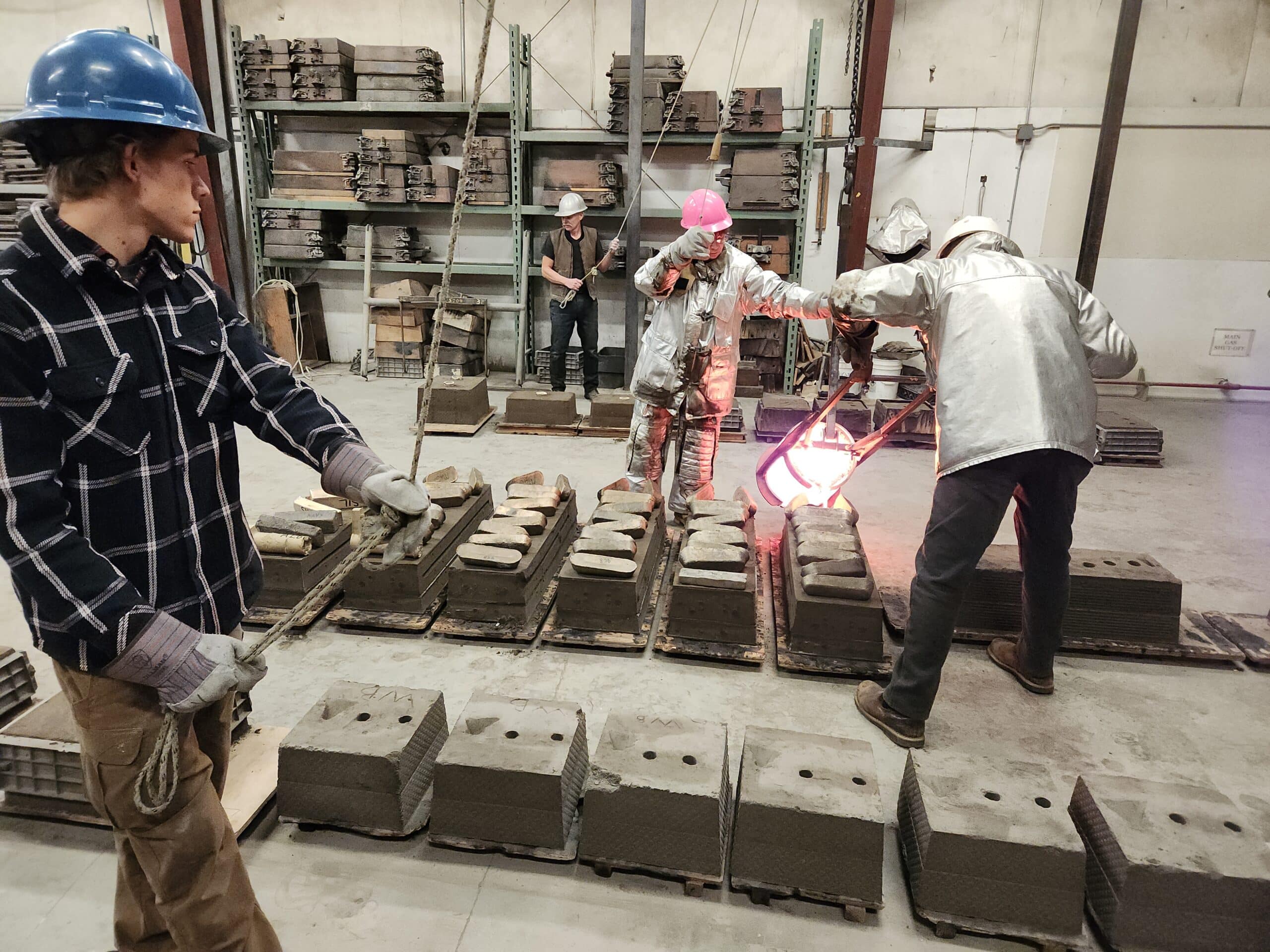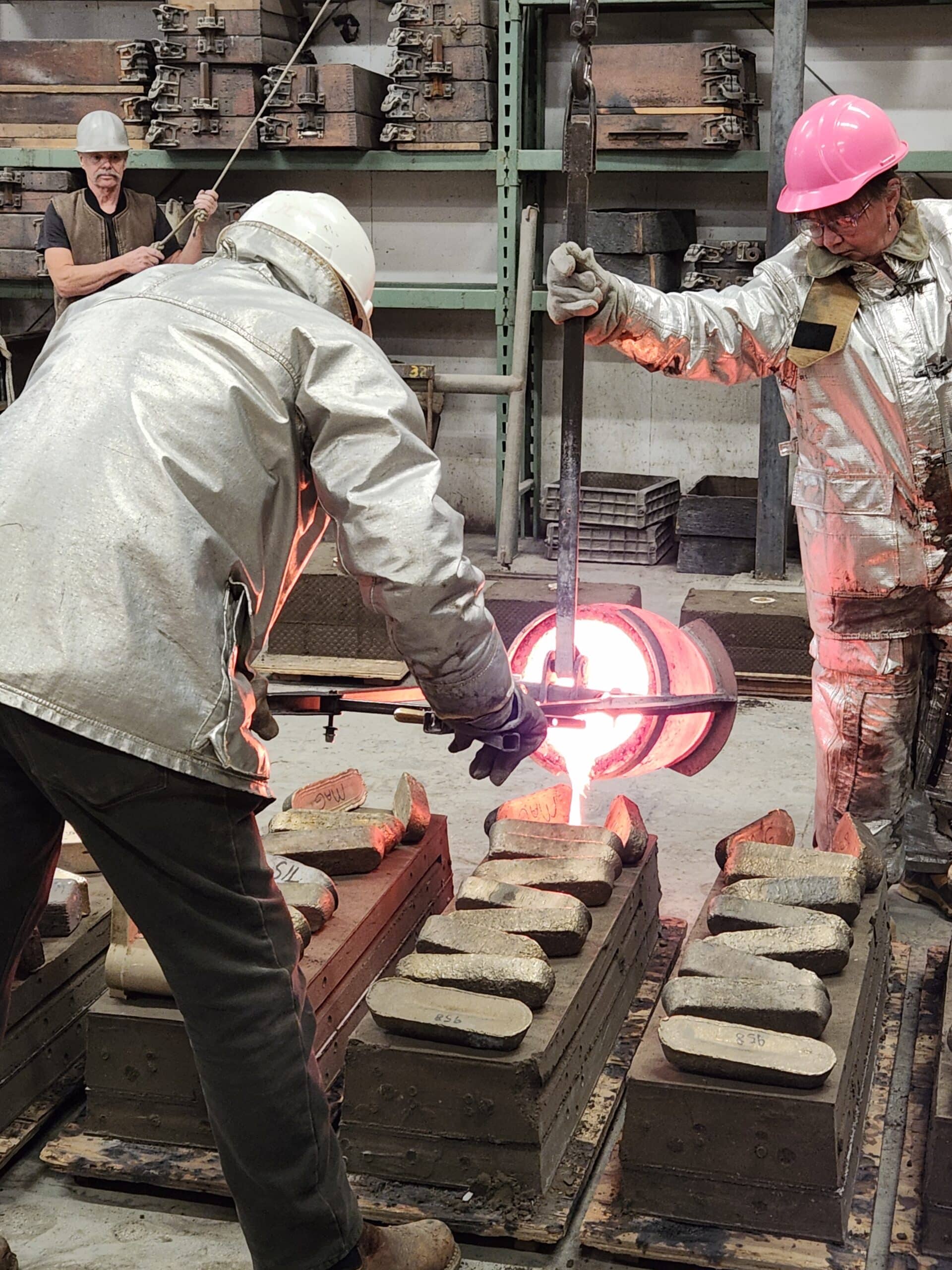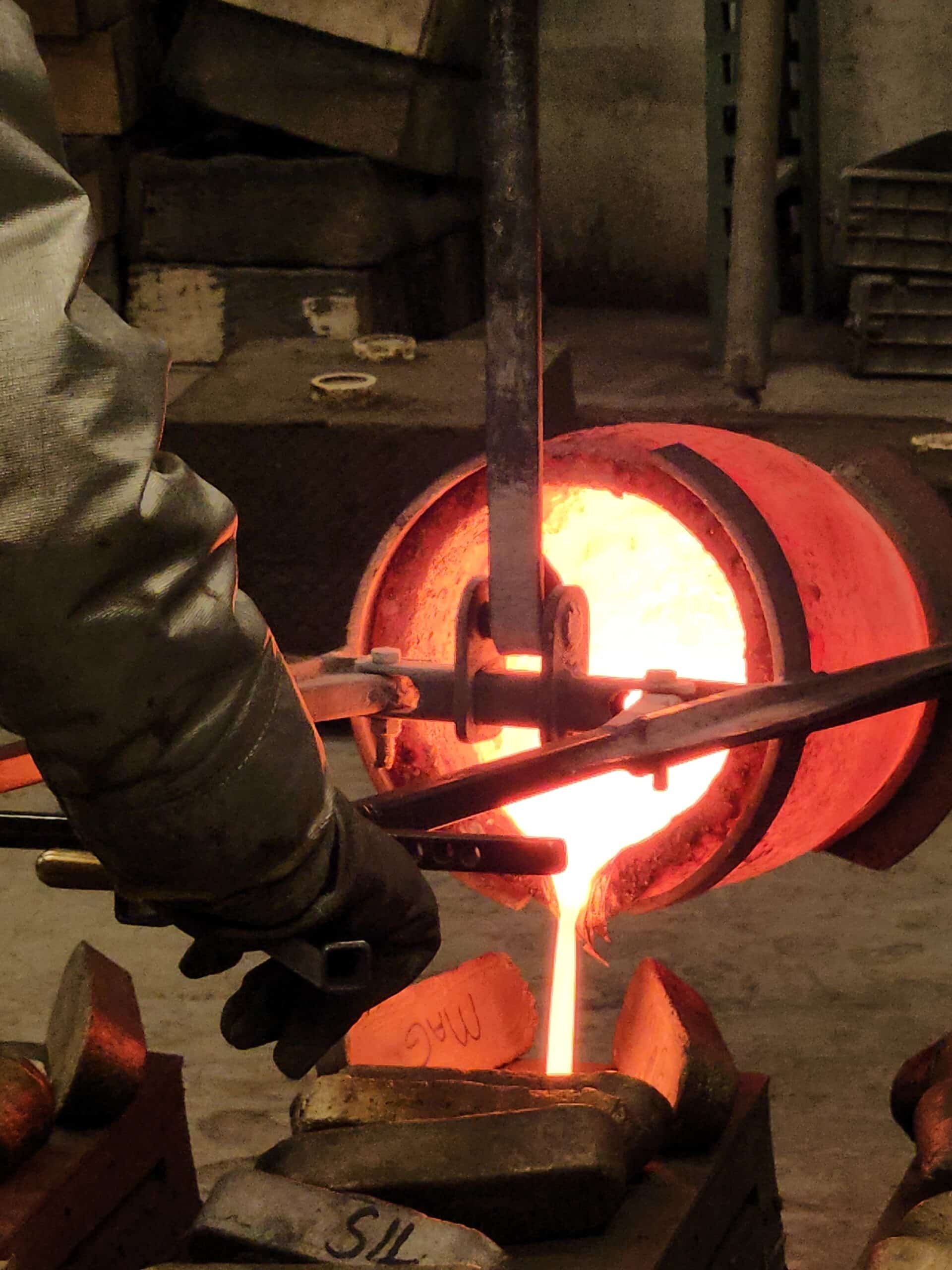National Heritage Areas are based on partnerships: bringing together a range of Tribes, organizations, businesses, and governments around heritage resources and stories. One of our partners is the Port Townsend Foundry. If you are interested in becoming a partner, learn more on our become a partner page.
Workers at the foundry warm their hands over the flaming cauldron that holds a specialized mixture of metals. On a drizzly December day, the intense heat from the furnace is pleasant—at least 20 feet away—as Pete Langley gets a few last things in order and puts on a heat-reflective suit. He’s getting ready to pour molten metal into specialized handmade sand molds to create new parts for a Navy vessel, and it’s important that the mixture is at the perfect temperature. Too hot, and you burn away essential materials. Too cold, and it doesn’t flow through the mold
Attaching the red-hot crucible to a tall overhead crane, Pete and his wife Cathy pull the slag material from the top of the pot, tossing it into a loose pile beside them. Moving carefully and quickly with the practiced grace of more than 40 years of experience, he pours the molten bronze from the crucible into a small hole at the top of the form. In a few hours, the sand will be knocked away, and a new part will be ready to be machined, shined, and sent off to a client.
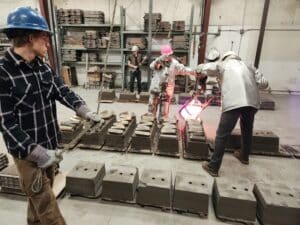
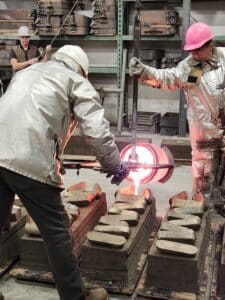
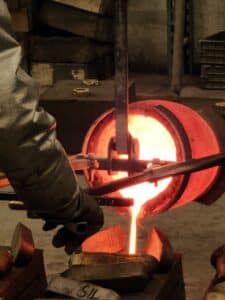
Pete Langley and the Port Townsend Foundry
Pete Langley is the co-owner of the Port Townsend Foundry, a brass foundry that specializes in maritime ship parts. With an expansive archive of wooden templates for everything a ship might need, he works to be the one-stop-shop for bronze parts. From round porthole window frames for historic galleons, to ship cleats that replace those given to departing Navy crewmembers, his foundry specializes in the unique materials, designs, and specifications that are needed by a multitude of ships both old and new in fleets around the world.
Much of his shop’s space is taken up by tall shelves of parts, both wooden and metal, that serve as the basis for future replications. Many of them are parts that Pete’s team has created from scratch over the years, but many more are parts saved from other foundries, manufacturers, and artisans. Pete’s goal is to be able to make a part for any ship, and with his expansive library and dedicated team, he seems able to do just that.
It’s not just maritime parts, however. Creating everything from bearings for a local paper mill, crests and badges for decorations, and concrete and steel benches shaped like massive cleats, his shop has many roles for the community. He especially prides himself on his foundry being a place where young people can learn a trade—though the youngest people who start working there “get to do nothing but clean the machines and oil them,” Pete laughed. But eventually, they do take part in the casting and design processes, hopefully encouraging them to participate in the field long-term.
The Port Townsend Foundry
Pete has been running the foundry since re-establishing it in 1983—100 years after the original Port Townsend Foundry opened on the Port Townsend waterfront. These days, he’s located a few minutes outside of town and has a larger shop space with his library of wooden patterns, extra parts, a full machine shop, and even a family boat in a side yard.
Pete’s library of wooden patterns means that he has a living collection of all the bits and bobs a ship might need. He also prides himself on the quality of his production.
A cast part has a tensile strength thousands of times higher than one that has been welded. Pete takes this need for extreme quality very seriously. He won’t re-use a piece of metal if he isn’t 100% sure of its constituent materials, and any new projects the foundry creates are made with precise portions of copper, zinc, aluminum, and other metals. Once parts have been cast, his machine shop cleans them to an accuracy of thousands of an inch, without any computerized assistance. There’s even a granite table calibrated for aerospace-grade parts.
“You know, after 43 years, we got pretty much an international reputation. So yeah, certain classes of people who are going to be offshore, dedicated sailors, they know they don’t want any junk—failure’s not the option,” said Pete.
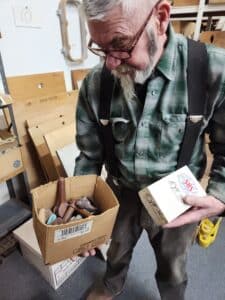
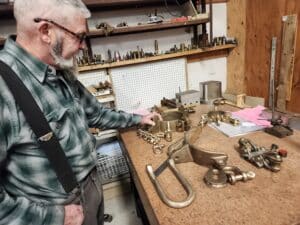
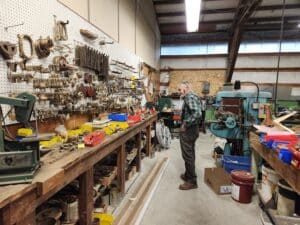
How it’s Made
On the occasion when Pete’s team needs to create a part from scratch rather than from their expansive library, it goes through a process of artistry, design, and mathematics that makes for high-quality, long-lasting parts. His decades of experience with boating mean that he knows what parts need to be made with specific alloys to make them effective and long-lasting. The physics of hot metal means that by accounting properly for the shrinkage while cooling, his team can create paper plans and wooden templates that enable replication of the part. These templates are then stored in the archival room, next to their drafting area.
When an order comes in for a part, Pete’s team will either work with a client to create a custom design or use one of their thousands of existing templates. “All I really need is a boat drawing or the name of the boat, and then pretty much I can figure out what the needs are,” said Pete.
Based on the needs of the client, they prepare a wooden template and press it into a special mixture of sand, water, and bentonite clay that is incredibly heat resistant and very smooth. This lets the molten bronze flow through even very small design details like the letters on a sign.
The wooden template is then removed from the sand form, and a member of the team carefully scrapes and blows away excess sand, ensuring that the final casting is accurate and complete.
The sand form is placed underneath the tall overhead crane on the shop’s floor as the specific mixture of metals for the part is heated in the crucible. This could include recycled failed castings or raw metal, as long as the specific composition is known. Pete’s team dons their heat-resistant clothes, the gas is shut off for the furnace, and the roar of the flames dies down. A clamp is affixed to the crucible, and hundreds of pounds of liquid metal are lifted from the furnace.
After a short break to remove excess slag floating on the metal from reactions with the air, they move quickly to pour the metal into the molds. Metal bars hold the molds in place, and a new product is cast.
After the casting cools, the sand is knocked away for future reuse, and the part proceeds to the other side of the foundry, where the machine shop is located. There, it’s sandblasted, carved, trimmed, and polished to be ready for sale to a client. For a given part, this could be a special process done only once, or a project for dozens of identical parts used across multiple ships and fleets.
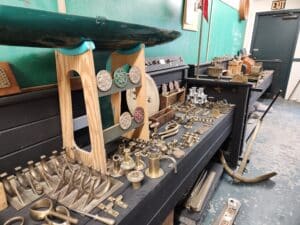
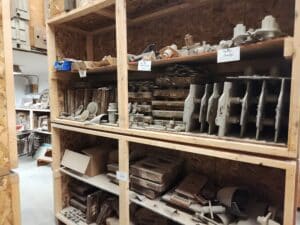
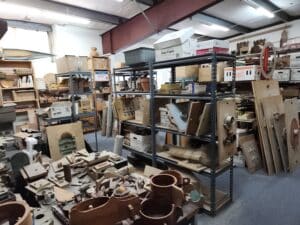
Maintaining Washington’s Maritime Heritage
Many foundries exist that could do similar work, but Pete’s dedication to archiving and saving parts from so many different ships makes his shop different than most machine shops and foundries. His role is important to preserving Washington’s maritime history—some of his patterns date back more than 100 years—but why does he do it?
“For me, it’s maintaining the working waterfronts and the culture,” said Pete. “It’s all part of that long-range story that needs to be told,” said Pete. He’s proud of the work that he’s done to establish the Port Townsend Foundry over the last 40 years to support those working waterfronts.
The Future of the Foundry
Despite running such an important resource to maritime communities, there are challenges for the foundry’s future. “When I started the foundry in 1983, there were 389 foundries in the state of Washington. There’s less than 40 of us left,” said Pete.
“We’re hoping that the next generation will be an employee-owned company. … Obviously now I’ve done 43 years so I can pretty much step in or out anytime. … I’d like to be able to help the next generation carry it on and move into the future.”
One of the ways Pete works within his community is by employing disenfranchised youth who might otherwise not be involved in trades, he said. He feels strongly that the key for any community is to favor the youth, and by getting them into the business and industry to see what really goes on, he hopes to secure the future of both his foundry and his local community.
To that end, the Port Townsend Foundry is always looking for new hands who might be interested in continuing their legacy of design artistry, skill, and teamwork that keeps vessels around the world running.


